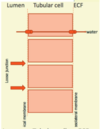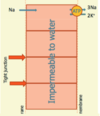Changes in Plasma Volume and Renal Control of Blood Pressure Flashcards
Where is the water in the body located?
- Intracellular fluid (ICF)
- Extracellular fluid (ECF)
What seperates the intracellular fluid and the extracellular fluid?
The cell membrane
What tightly regulates the volumes of the ICF and ECF?
Their ionic compositions and osmosis
What is ECF volume determined largely by?
The concentration of NaCl
How can the kidney maintain the ECFs volume within a very narrow margin?
By regulating the excretion of NaCl
What must the kidneys balance?
The amount of Na+ excretion with ingestion
What is the process of matching Na+ secretion with ingestion called?
Sodium balance
What is meant by a patient being in positive balance?
Na+ excretion is less than intake
What happens when a patient is in positive balance?
ECF expansion
Why does a positive sodium balance lead to ECF expansion?
Na+ is retained in the body, primarily in the ECF. Water is drawn out of the nephron causing a corresponding increase in volume
What happens as a result of ECF expansion?
With respect to blood volume and arterial pressure
- Blood volume increases
- Arterial pressure increases
Oedema may follow
What is meant by a patient being in negative balance?
Na+ excretion is greater than intake
What happens when a patient is in negative balance?
ECF contraction
Why does a negative sodium balance lead to ECF contraction?
The Na+ content of the ECF decreases, so less water is drawn out of the nephron, so ECF volume decreases
What happens as a result of ECF contraction?
With respect to blood volume and arterial pressure
- Blood volume decreases
- Arterial pressure decreases
Do changes in Na+ affect ECF osmolarity?
No
Why doesn’t changes in Na+ balance affect ECF osmolarity?
If the concentration of Na+ in the ECF increases, then volume increases. The increase in volume gives increased cardiac output, and increased Na+ excretion
What % of Na+ is filtered in the glomerulus?
100%
What % of Na+ is reabsorbed in the PCT?
67%
What is meant by glomerular tubular balance?
The proportion of Na+ reabsorbed is always the same, regardless of the actual amount that is filtered
What does autoregulation do?
Prevents GFR from changing too much
What is the result of glomerular tubular balance?
If any changes in GFR occur, it blunts out the Na+ excretion response
Is Na+ reabsorption an active or passive process?
Mainly active
What drives Na+ reabsorption?
3Na-2K-ATPase pumps on the basolateral membrane
What do different segments of the tubule have?
Different types of Na+ transporters and channels in the apical membrane
Draw a diagram illustrating the different segments of the tubule that have different types of Na+ transporters and channels

What happens in section 1 of the tubule?
- Na+ reabsorption
How does Na+ reabsorption occur in section 1 of the tubule?
- Co-transported with glucose
- Na-H exchange
- Co-transport with AA or carboxylic acids
- Co-transport with phosphate
Other than mechanisms to reabsorb Na+, what does section 1 of the tubule have in its membrane?
Aquaporin
What happens to the concentration of urea and Cl- down section 1 of the tubule?
It increases
What is the purpose of the increase in Cl- concentration down section 1 of the tubule?
It increases the concentration gradient for Cl- reabsorption in sections 2 and 3
Draw a diagram illustrating Na+-Glucose cotransport in section 1 of the tubule

What happens in sections 2 and 3 of the tubule?
- Na+ and water reabsorption
- Cl- reabsorption
How do sections 2 and 3 of the tubule reabsorp Na+?
Na-H exchanger
How do sections 2 and 3 of the tubule reabsorb water?
Aquaporin
How do sections 2 and 3 of the tubule reabsorb Cl-?
- Paracellular Cl- reabsorption
- Transcellular Cl- reabsorption
Draw a diagram illustrating the processes that occur in sections 2 and 3 of the tubule

What is the overall result of movement of substances in the tubule?
It sets up an ~4mOsmol gradient favouring water uptake from the lumen
How water permeable is the PCT?
Highly
What does the high water permeability of the PCT allow?
Reabsorption to be isosmotic with plasma
What is the reabsorption of water in the PCT driven by?
- Osmotic gradient established by solute reabsorption
- Hydrostatic force in the intersticium
- Oncotic force in the peritubular capillary
What produces the oncotic force in the peritubular capillary?
The loss of 20% filtrate at the glomerulus, but cells and proteins remained in the blood
Label this graph illustrating how well substances are reabsorbed

- A - Chloride
- B - Phosphate
- C - HCO3-
- Glucose, AA, and lactate
What is meant by glomerulotubular balance?
The balance between Glomerular Filtration Rate and the rate of reabsorption of solutes
What must be true of the glomerulotubular balance?
It must be kept as constant as possible, so if GFR increases, the rate of reabsorption must also increase
How much Na+ is reabsorbed in the PCT?
67%, regardless of GFR
How does an ECF volume increase cause an increase in GFR?
If ECF volume increases, cardiac output will increase, causing an increase in arterial blood pressure, which in turn will increase GFR
What happens to the reabsorption of solute and water in the loop of Henle?
It is separated
What is reabsorbed in the descending limb?
Water, but not NaCl
What is reabsorbed in the ascending limb?
NaCl, but not water
What is the ascending limb known as?
The diluting segment
Why is the ascending limb known as the diluting segment?
Because it dilultes NaCl in the filtrate
How does tubule fluid leaving the loop compared to the plasma?
It is hypo-osmotic (more dilute)
Draw a diagram illustrating the seperation of reabsorption in the loop of Henle

What does the increase in intracellular concentrations of Na+ set up by the PCT allow for?
Paracellular reuptake of water from the descending limb
Are there tight junctions in the descending limb?
No
What is the result of the paracellular reuptake of water from the descending limb?
It concentrates Na+ and Cl- in the lumen of the descending
Why does Na+ and Cl- need to concentrate in the lumen of the descending limb?
Ready for active transport into the ascending
Draw a diagram illustrating reuptake in the descending limb

Is the ascending limb permeable to water?
No
Why is the ascending limb impermeable to water?
Tight junctions
Draw a diagram illustrating uptake in the ascending limb

What happens in the thick ascending limb (TAL)?
- NaCl is transported from the lumen into cells by NaKCC2 channel
- Na+ then moves into the intersticium due to the action of 3Na-2K-ATPase
- K+ ions diffuse back into the lumen via ROMK
- Cl- ions move into the Intersticium
What is NaKCC2 a target of?
Loop diuretics
What does increased loss of K+ in the urine lead to?
Hypokalaemia
How does the energy use of the thick ascending limb differ from other regions of the nephron?
It is much higher
What is the TAL particularly sensitive too?
Hypoxia
Draw a diagram illustrating what happens in the TAL

How water permeable is the DCT?
Fairly low
What does the active reabsorption of Na+ in the DCT result in?
Dilution of the filtrate
What enters the distal convoluted tubule from the loop of Henle?
Hypo-osmotic fluid
What happens to the hypo-osmotic fluid in the distal convoluted tubule?
5-8% of its Na+ is actively transported
How is Na+ actively transported in the DCT?
NaCC
What drives NaCC?
3Na-2K-ATPase
What is the NCC transporter sensitive too?
Thiazide diuretics
What is the DCT a major site of?
Calcium reabsorption via PTH
What is the result of dilution in the DCT?
The fluid that leaves is more hypo-osmotic
Draw a diagram illustrating what happens in the DCT

What is the collecting duct?
The region responsible for fine-tuning the filtrate
What is the collecting duct able to do?
Respond to a variety of stimulants
What are the distinct cell types of the collecting duct?
- Principal cells
- Intercalated cells







